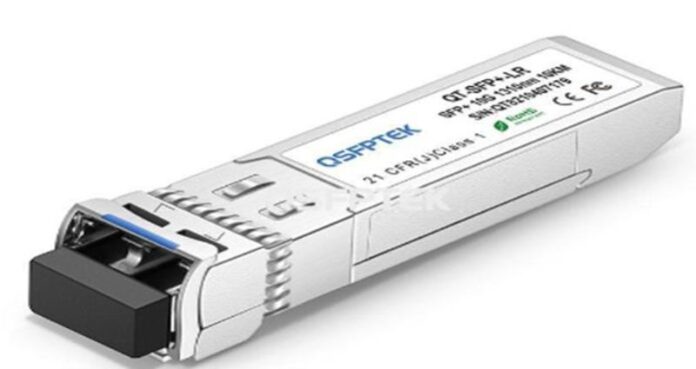
The SFP-10G-LR optical module conforms to the 10GBase-LR specification, and the maximum transmission distance on single-mode fiber with a wavelength of 1310nm is 2m to 10km, and in fact, it can reach up to 25km.
10GBASE-LRM Explained
10GBASE-LRM is a 10 Gigabit Ethernet specification in the IEEE802.3aq standard released in 2006. The LRM is Long Reach Multimode, which refers to the length extension multi-point mode.
The SFP-10G-LRM conforms to this specification The optical module is mainly used for 260m short-distance local area network connection. There is also an SFP-10G-LRM2 optical module, which is an upgraded version of the SFP-10G-LRM optical module, which can be used to transmit 2km short-distance local area network connections.
Why We Need 10GBASE-LRM
There are two types of 10G Ethernet ports that support multimode fiber, namely 10GBASE-SR and 10GBASE-LX4. Why did IEEE 802.3 create another multimode fiber port type, 10GBASE-LRM? Here’s why:
- 10GBASE-SR can only support a distance of 300 m only if the new high-bandwidth 0M3 (50 m core) multimode fiber is installed. On the low-bandwidth multimode fibers OM1 and OM2 that are usually installed, 10GBASE-SR can only be used for interconnection between devices in the equipment room.
- 10GBASE-LX4 is an expensive WDM solution. It is a robust solution for the early market. However, fundamentally, it cannot meet the requirements of the mature market, that is, the requirements of low cost, high volume, low power and miniaturization.
- The installed number of OM1 and OM2 fibers is huge and growing, requiring a truly economical 10G Ethernet solution.
As a result, IEEE 802.3 mandated the development of 10G BASE-LRM, a single-wavelength serial transmission specification that is compatible with low-cost, low-power, and miniaturized optical ports, supporting installed multimode fiber with link lengths in excess of 220m.
Advantages of SFP-10G-LRM Optical Modules
The SFP-10G-LRM optical module has a maximum transmission distance of 260m in multimode fiber with a wavelength of 1310nm, supports the 10GBASE-LRM Ethernet standard, and is suitable for FDDI networks and 10G data communications.
Its low power consumption and excellent EMI performance Fully comply with the MSA SFF-8431 standard; the excellent unlocking ring fully complies with the MSA SFF-8432 standard, this optical module also uses its own structural design, and also supports the digital diagnosis function realized by MCU.
Features of SFP-10G-LRM Optical Module
- Utilize the existing 10G Ethernet serial LAN PHY encoding sublayer;
- The bit error rate does not exceed 10-12;
- Multimode fiber supporting 62.5μm core: including 160/500MHz-km & 200/500MHz-km (OM1);
- Multimode fiber supporting 50μm core: including 400/400MHz-km, 500/500MHz-km (OM2), & 1500/500MHz-km (OM3)
- Provides a physical layer specification that supports the following link distances: on installed 500 MHz-km multimode fiber, support a minimum link distance of 220 m; on selected multimode fiber, support a minimum of 300 m link distance
Application of SFP-10G-LRM Optical Module
The SFP-10G-LRM optical module can achieve a transmission distance of 300m on installed OM1 and OM2 multimode fibers. Achieving this application overcomes the following major difficulties:
- The fiber bandwidth of the 10GBASE-LRM specification is very low and cannot provide enough bandwidth for 10Gbps serial NRZ transmission;
- In the statistical distribution of optical fibers, low-bandwidth optical fibers and high-bandwidth optical fibers account for a large proportion;
- For a specific fiber link, the static impulse response is related to the emission of the laser, the connector, and the link length. In addition, the impulse response fluctuates with the mechanical disturbance of the fiber;
- Transmission problems caused by noise.
The above is the difference between the relevant knowledge of the SFP-10G-LRM optical module and the SFP-10G-LR optical module. QSFPTEK can provide users with comprehensive network system solutions to help users build low-cost, high-efficiency, and easy-to-maintain network systems. The stability of 10G optical modules has been highly recognized by the majority of users.

